An ecotourism project
At once playful & educational
Too often, modern tourism involves traveling many kilometers by car or plane, even though our country is rich in landscapes and natural treasures conducive to the development of ecotourism.
At the heart of unspoilt nature, visitors discover a biodiversity that is still too little known, right before their very eyes. Sustainable ecotourism means remembering the importance of nature in our daily lives. That’s why we’re doing everything we can to enable the wild to regain its place in a dedicated sanctuary, and to raise awareness among young and old alike, in a fun and educational way, through a multitude of activities.
Because the development of responsible tourism in France involves pioneering projects, the Réserve animalière des Monts d’Azur still stands today as one of the spearheads of ecotourism; which will only grow stronger as humans become more aware of their environment.
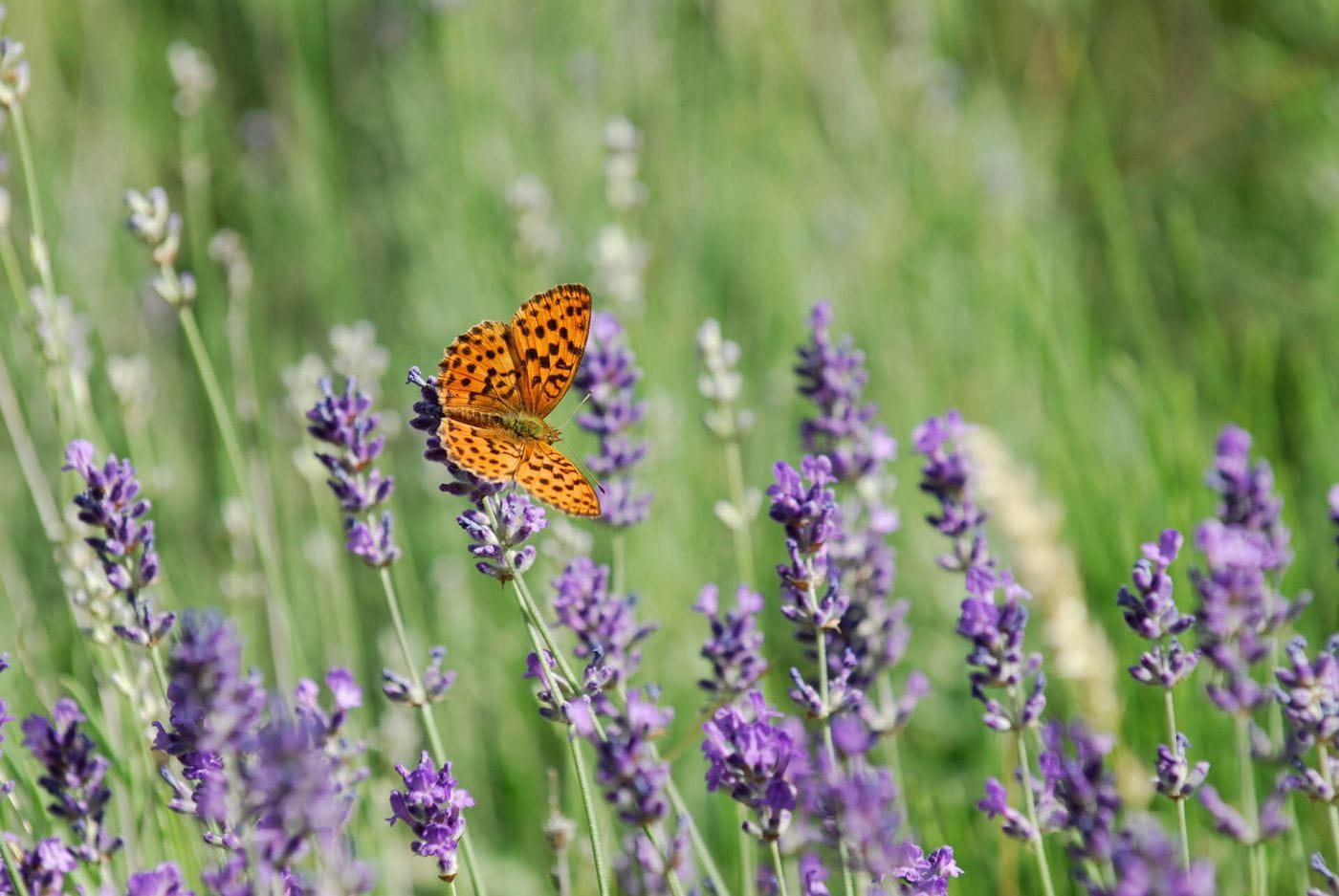
Our natural swimming poolan eco-responsible action
Resource yourself during your stay and take advantage of our natural swimming pool to reconnect with well-being in an eco-friendly way!
This natural bathing area has been designed for your pleasure in accordance with public health regulations and in the spirit of conservation of the Monts d’Azur Reserve. We do not use bactericidal products or ph correctors. We leave it to nature to purify the water. Set in motion by an elaborate pumping system, the water passes through a natural biotope before returning to the pool. This aquatic garden cannot be trampled and no visitor should enter this plant world.
The water in the natural pool is rich in plankton, which contributes to the purification processes. Consequently, any chemical products are forbidden, including sun creams or oils!
Let yourself be seduced by this natural luxury and entrust your comfort to our microscopic staff! Back to basics and a vitality cure guaranteed!
UNSUPERVISED SWIMMING:
Children must be accompanied by an adult
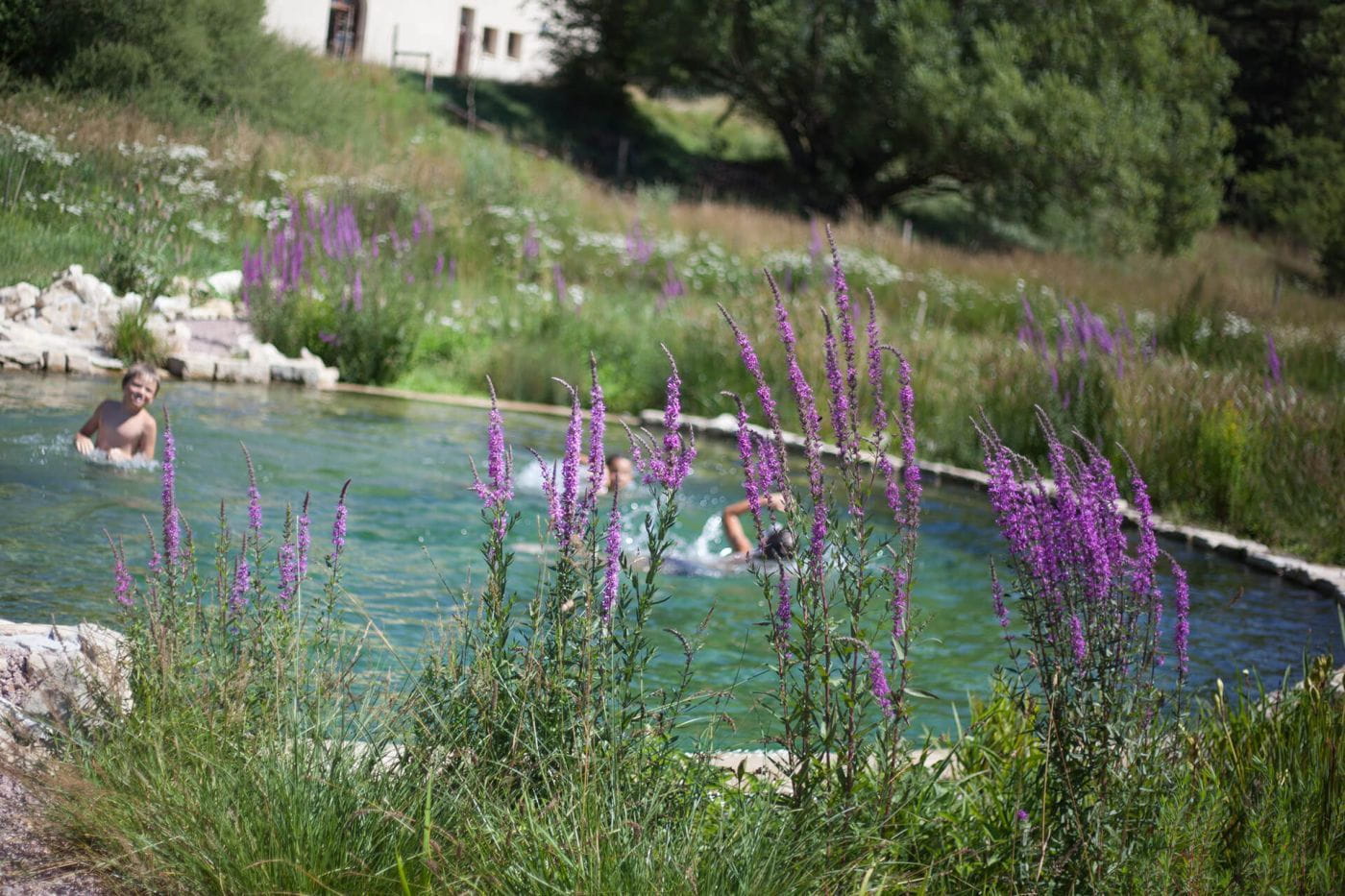
Pilot example of ecotourism & holidays
in a remarkable natural site
Tourism activity can have, in previously unspoilt natural areas, a significant environmental cost due to:
– the creation or development of necessary transport and accommodation infrastructures;
– the seasonal over-consumption of natural resources, including water, as well as of natural areas themselves;
– the over-capacity of wastewater treatment facilities
– exceeding wastewater treatment or household waste processing capacities.
.
Based on this observation, the Preserve association, together with the relevant departments of the Conseil Général and the Préfecture, has conducted a study aimed at promoting solutions to significantly reduce the environmental impact of tourism in order to encourage the development of ecotourism.
Three avenues are currently being explored on the Monts d’Azur Biological Reserve site:
1. Reduce the impact of existing or future infrastructures:
The Haut pays is characterized by the presence of numerous old buildings of agricultural or industrial origin, as well as sometimes imposing dwellings, now abandoned (village of Thorenc). Environmental considerations call for the rehabilitation of existing buildings rather than the construction of new ones, especially as a number of bioclimatic renovation techniques are now available, some of which have been implemented by the association préserve, with the support of the Conseil Général and the French government.
The Haut pays is also characterized by its high quality of life.
The Haut pays is also characterized by the beauty and diversity of its unspoilt landscapes. Over the next ten years, tourism is set to develop here. All players in the industry will need to take into account the priceless value of the landscape and design accommodation structures that are perfectly integrated into the natural environment, economical in terms of space and materials, and where possible, demountable. This is the Ecolodge concept inaugurated in the summer of 2009 as part of the rural centers of excellence.
2. Managing natural resources: fauna, flora, water:
To be sustainable, tourism must imperatively take into account the scarcity and fragility of natural resources. They are a major strategic issue and must be rigorously managed.
Developing ecotourism and ecologically-oriented vacations on a fragile territory and saving water or managing waste, organizing site frequentation and preserving or increasing biodiversity, developing the Reserve and identifying ecological services are the daily challenges facing those in charge of the Monts d’Azur Reserve.
3. Encouraging alternative modes of travel:
Tourism development in a fragile region calls for infrastructure-saving modes of transport. Driving is one of them. Most of the existing trails are usable provided you have light, perfectly suspended horse-drawn carriages.
Our eco-responsible actions in the reserve
experimental rehabilitation of a 19th-century villa
LA VILLA BIOCLIMATIQUE – OBJECTIVES:
– Rehabilitate an old villa to create 5 bedrooms from 2 to 4 beds;
– Test new renovation solutions;
– Develop an ecological habitat that is self-sufficient in energy and water.
The renovation was preceded by a bioclimatic analysis of this villa: location, altitude, exposure, snow cover, rainfall, extreme temperatures, nature of materials used.
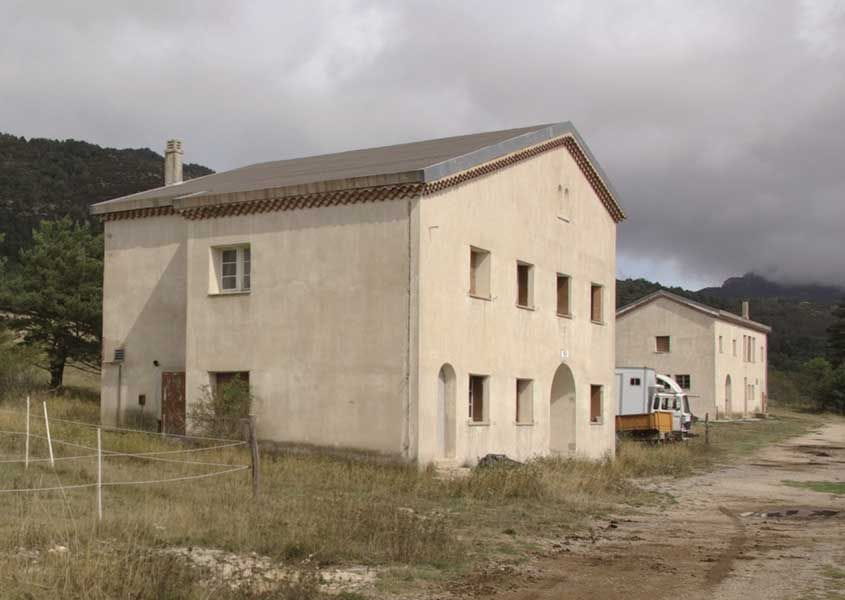
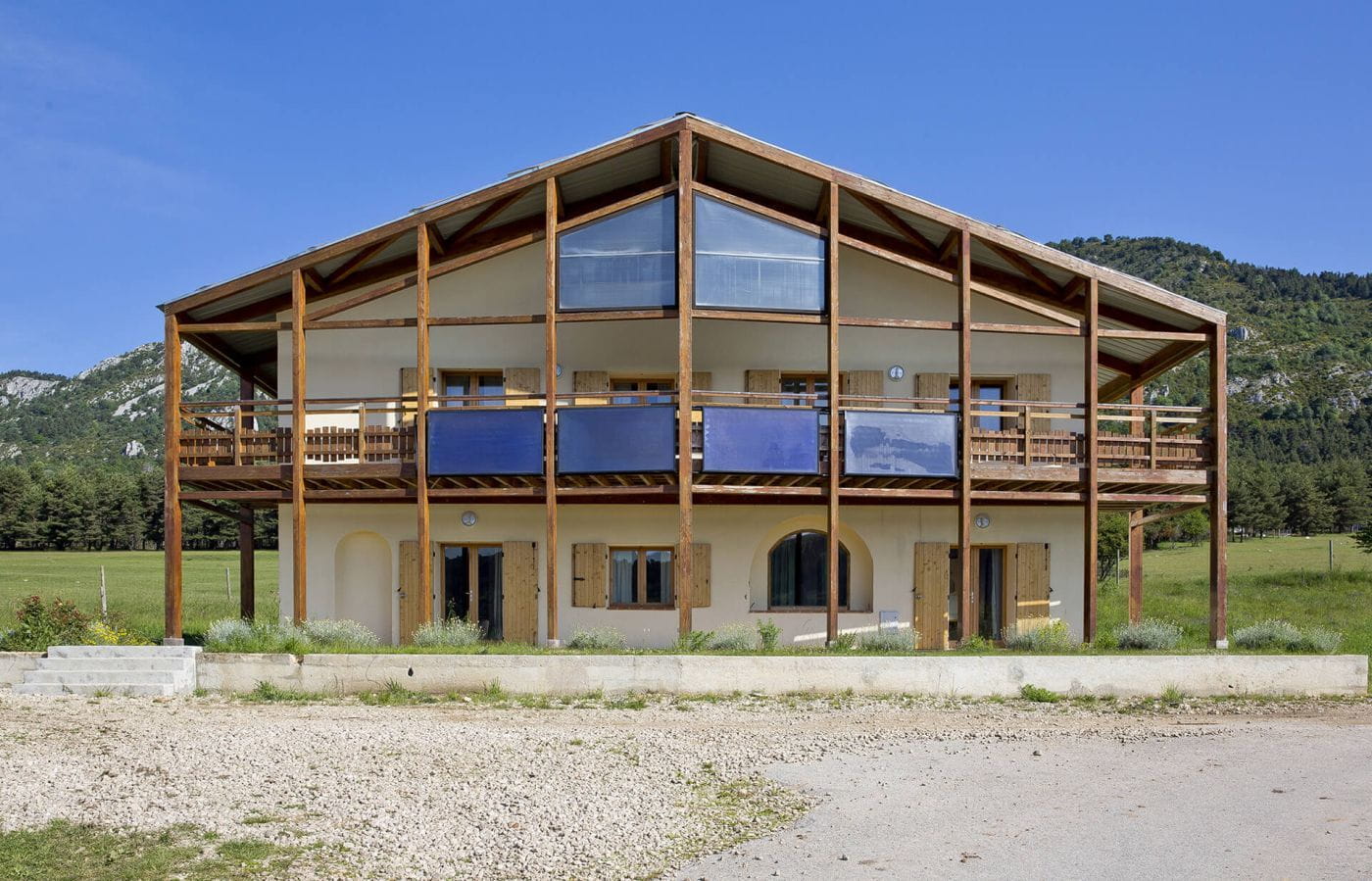
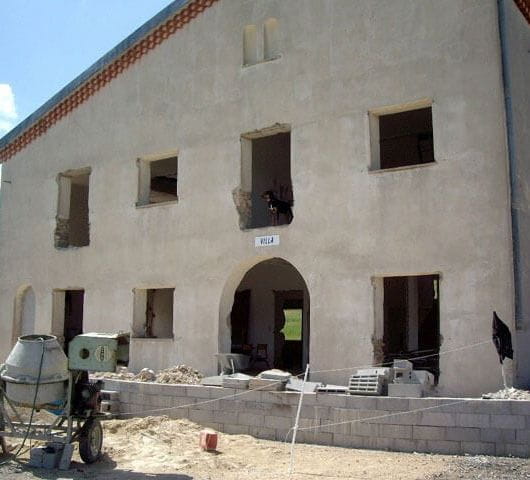
The exteriors
The stone walls, bound with a poor mortar but covered with a very solid rendering, have been preserved as well as most of the roof.
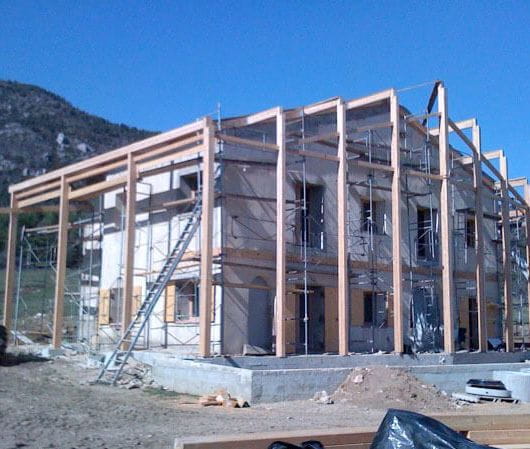
Balconies and roof overhangs
Provided for visitors to the Reserve, this villa features wooden balconies that encircle the building as in the traditional architecture of the village of Thorenc. Their function is threefold:
– protection from the sun in summer (in conjunction with overhanging roofs) and, on the other hand, optimization of sunlight in winter (adapted dimensions);
– exterior pedestrian circulation and optimization of space for the use of the balconies
– exterior pedestrian circulation and optimization of interior spaces;
wildlife observatories.
– wildlife observatories.
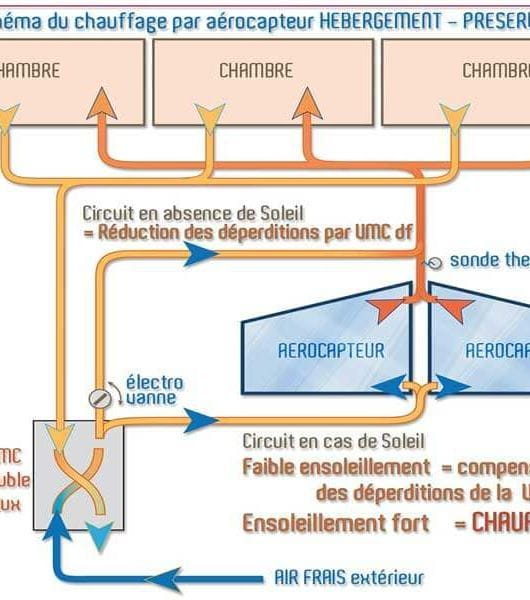
Experimental aerothermal collector
The aerothermal collector is designed and developed specifically for this project. The sun’s rays heat the air circulating in the translucent box. This preheated air is then blown by mechanical ventilation into all the rooms of the building.
These daytime calories are stored in the mass elements (floor slab, “Fermacell ” walls) to be released at night. The system works without additional power consumption, with the CMV used to push the air into the aerosensor.
This system is complemented by an underfloor heating system connected to a geothermal power plant, which provides the additional degrees required for the agritourism Home Page. This power plant comes into operation when sunshine becomes insufficient (overcast sky, very low outside temperature).
At night, thanks to the building’s energy performance, the double-flow ventilation alone can ensure, in most cases, an air temperature of 15 to 18°c.
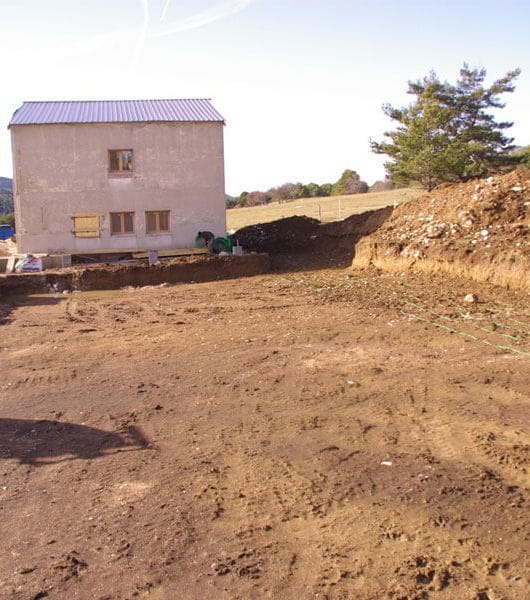
Solar hot water panels
They have been integrated into the facade balconies and enable the production of almost all the hot water consumed. A well-insulated 600-liter tank stores the necessary domestic hot water.
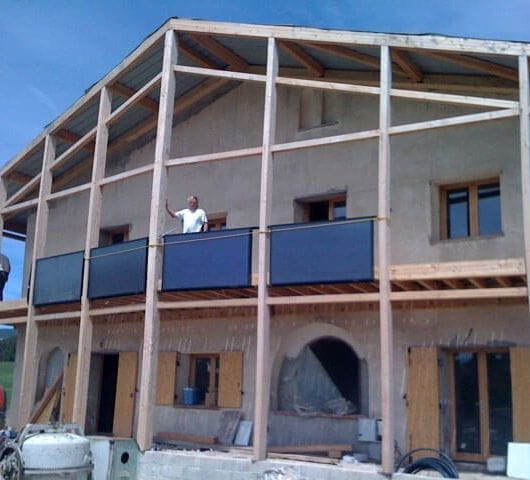
Outer superstructure
Built in laminated Douglas fir, naturally class 3, it requires no special treatment.
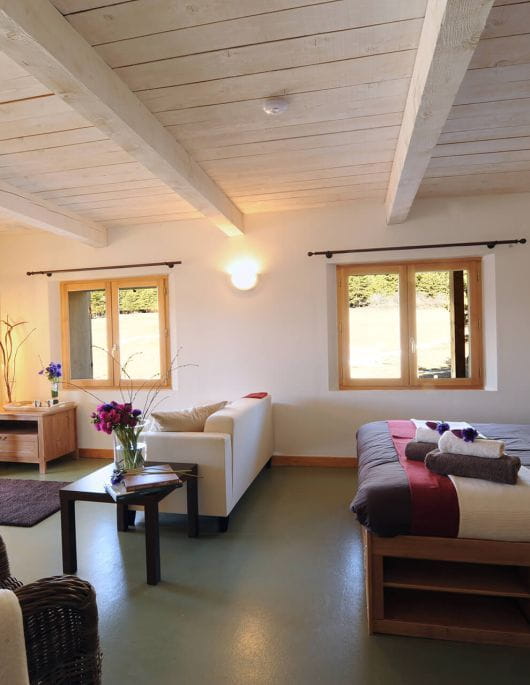
Interiors
The same principles of bioclimatic architecture have been implemented, with emphasis on:
– solar energy: the majority of rooms have two south-facing openings (4/5 rooms).
– natural insulation: local wood (false ceilings) and cellulose wadding for walls and ceilings. The cellulose wadding comes from recycled local newspapers. It combines very high thermal performance (thermal resistance coefficient of 4 for walls, 6 for ceilings) and lightness.
.
– interior heat storage in partitions made of either cellular concrete or gypsum panels mixed with cellulose fibers.
isothermal joinery
– isothermal joinery in European wood (French pine). All exterior joinery has been replaced with 4/16/4 double glazing. In addition, all openings were fitted with solid wood shutters.
– the installation of geothermal heating with a horizontal collector distributing all the rooms.
A room thermostat has been installed in each bedroom. Heating will be provided by a heating circuit poured into a liquid screed floor. This process considerably enhances geothermal energy input. The lime slab also enhances the building’s bioclimatic performance.
Electricity and lighting
Both interior and exterior lighting are fitted with low-energy bulbs. The common areas are equipped with presence detectors.
ALL SYSTEMS COMBINED, THE REDUCTION IN ENERGY CONSUMPTION IS NEARLY 70%!
Reducing water consumption
Showers in preference to baths and water flow savers on every water point.
A reducer screwed onto the end of the faucet channels the jet and reduces the water flow from 15 liters/min (standard flow) to 6 liters/min THAT IS A SAVING OF 60% FOR EQUIVALENT COMFORT.
A regulator installed on a showerhead induces a 50% saving on water consumption, reducing the showerhead flow rate from 20 liters/min to 9 liters/min.
Gray water recycling
A 350 m² natural lagoon with a volume of 250 m3 ensures complete purification of wastewater, which is then used to feed a wetland rich in several hundred species of aquatic plants, shrubs and trees. This area is also a refuge for aquatic avifauna (great grebe, common snipe, etc…)